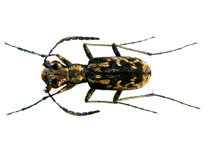Abstract
Nannophrys Günther, 1868, a group of flat-bodied frogs, is an endemic Sri Lankan genus bearing three extant and one extinct species, adapted to live among narrow and horizontal rock crevices adjacent to clear water streams. One of these species, Nannoprhys marmorata Kirtisinghe, 1946 is mostly restricted to the rock strewn streams of the Knuckles region (200–1200 m asl). Here, we re-describe the osteology of Nannophrys marmorata highlighting apomorphies and adaptations for life between narrow spaces. Previous studies on skeletal morphology of the genus Nannophrys include Gunther (1869), Boulenger (1882, 1890), Noble (1931), Kirtisinghe (1946), Clarke (1983) and Scott (2005). Basic descriptions of the skeleton of N. marmorata have been done (Kirtisinghe 1946; Clarke 1983), on which we build and elaborate. We describe the osteology using three adult specimens (SVL= 35.2–36.5 mm) of N. marmorata, stained differentially for bone and cartilage following the procedure by Taylor and Van Dyke (1985); we follow the osteological terminology of Trueb (1973), Duellman and Trueb (1986), and Pugener and Maglia (1997, 2009).

